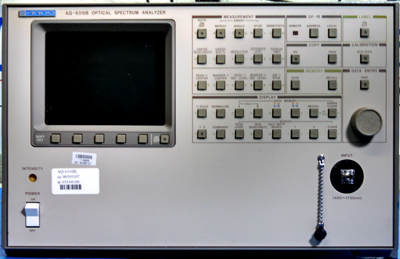
|
|
The Ando AQ-6310B is a general-purpose wavelength characteristic measuring instrument. It measures not only the LD, LED, and other light source spectrums, but also the loss wavelength and transmission characteristics of optical fiber cables, filters, and other devices. The AQ-6310B has a wide wavelength measurement range of 400 to 1750 nm, a high sensitivity to permit measurement of light as weak as -70 dBm, a wavelength resolution of ± 1 nm, and a high sweep rate, thereby covering a wide scope of applications. In addition to the basic functions such as the center wavelength, sweep width, resolution, and reference level setup functions, the AQ-6310B performs various other functions including the averaging, data memory, data subtraction, marker, peak search, half-width search, label, normalize, dominant, and 3-D display functions. Specifications. Measurement wavelength range: 400 to 1750 nm. Measurement level range: -80 to + 10 dBm/resolution (600 to 1600 nm) -70 to + 10 dBm/resolution (400 to 1750 nm). Linearity: + 1 dB / 60 dB, + 0.5 dB / 20 dB, ±0.2 dB / 10 dB. Level scale: 0.2 to 10 dB/div and LINEAR. Wavelength accuracy: ± 1 nm (5° to 40°C), ± 0.5 nm (25°C). Wavelength sweep width: 0.0 to 150 nm/div. Resolution: 0.1 to 10 nm (540 to 1750 nm), 0.1 to 5 nm (400 to 540 nm). Sweep time: 1 sec or less (span: 100 nm or less).
|